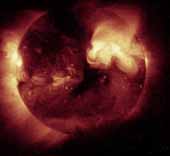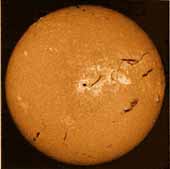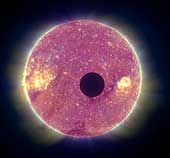Phobos' South Pole from Mars Express
This is a picture of the south pole of Phobos, the closest moon to Mars. In fact, it is so close that it is expected to crash into Mars within the next 100 million years! The moon is covered in circular craters, long chains of craters, and strange streaks. One of the most well known craters, Stickney Crater, is featured in this photograph. This photo is so detailed that it shows even items that are only 10 meters across. This and other similar photos are being used to scope out future landing spots for the Phobos-Grunt Mission. It is scheduled to launch later this year and return with samples in 2014. I think it is so incredible that we have the technology to take these pictures and to explore the moons of other planets!
Friday, January 28, 2011
APOD 3.1
Saturn Storm
A bright storm erupted on Saturn at the end of 2010. It was first spotted by amateur astronomers in the northern hemisphere of the planet. They spotted it in early December when Saturn was rising in Earth's predawn sky. On December 24th, the Cassini Spacecraft took this photograph from 1.8 million kilometers away. It is considered a complex distrubance. The storm has evolved since the picture was taken, and it is now stretches quite far around Saturn. It is pretty amazing that we are able to see such a large storm on another planet!
A bright storm erupted on Saturn at the end of 2010. It was first spotted by amateur astronomers in the northern hemisphere of the planet. They spotted it in early December when Saturn was rising in Earth's predawn sky. On December 24th, the Cassini Spacecraft took this photograph from 1.8 million kilometers away. It is considered a complex distrubance. The storm has evolved since the picture was taken, and it is now stretches quite far around Saturn. It is pretty amazing that we are able to see such a large storm on another planet!
Wednesday, January 12, 2011
Tuesday, January 11, 2011
Nevil Maskelyne Biography
Nevil Maskelyne
Nevil Maskelyne as born on October 6, 1732 in London, England. His father, Edmund Maskelyne of Purton ,Wiltshire died when Nevil was only 12 years old. He left the family extremely poor. Nevil attended Westminster School. His mother died when he was 16 years of age, while he was still enrolled at Westminster. After observing the eclipse of July 25, 1748, his passion for astronomy sparked. He enrolled at St Catherine’s College, Cambridge in 1749 where he studied mathematics, and was ordained as a minister in 1755. Being described as “well versed in mathematical learning and natural philosophy”, Maskelyne was admitted to the Royal Society in 1758. The Royal Society is a fellowship of the world’s most eminent scientists. In 1785, Maskelyne married Sophia Rose of Cotterstock, Northamptonshire, and had his only child, Margaret, in 1786. He died on February 9, 1811 at the age of 78.
Nevil Maskelyne was first despatched by the Royal Society in 1761 to the Island of St Helena. Here he was to observe a transit of Venus. His calculations were vital and needed to be very accurate, because they were to be used to calculate Earth’s distance from the Sun. In turn, the scale of the solar system would be determined. Maskelyne was unsuccessful in his observations because of bad weather, however he used his trip as a chance to experiment with determining longitude using the position of the moon. When he returned to England, he immediately began writing a book. In 1763, he published the lunar distance method for determining longitude in The British Mariner’s Guide.
In 1764, Nevil Maskelyne took a voyage to Barbados to carry out trials of Harrison’s timepiece. When he returned he was appointed Astronomer Royal and published the first volume of the Nautical Almanac in 1766. He continued to work on this project till his death.
Maskelyne was awarded the Copley medal of the Royal Society in 1775 for his work on determining the Earth’s density. He carried out an experiment using a plumb line on the mountain Schiehallion in Perthshire, Scotland. He computed that the Earth’s density is about 4.5 times water’s density.
Some of Nevil Maskelyne’s other impressive work includes several practical improvements. He was the first to come up with measurement of time to the tenths of a second! He was also able to convince the government to replace John Bird’s mural quadrant, an angle measuring instrument, with a repeating circle. The repeating circle was to be 6 feet in diameter. Unfortunately, Maskelyne was not alive to see it completed.
Because of Nevil Maskelyne’s extreme passion and dedication to the science of astronomy, we have been able to progress greatly in the subject. He was clearly a very large contributor to astronomy as we know it today.
Work Cited:
Dictionary of Scientific Biography, C. Gillispie, editor. Charles Scribner's Son. 1981.
"Nevil Maskelyne, Astronomer Royal." Pine Tree Web. Lewis P. Orans, 19 Sept. 2002. Web. 09 Jan. 2011. <http://pinetreeweb.com/bp-nevil-maskelyne.htm>.
Friday, January 7, 2011
APOD 2.5
Stardust in Aries
In this photograph, stardust is sprawled out over about 2 degrees of the sky. It is located near the constellation Aries and the plane of the Milky Way. There is also a beautiful light blue nebula, van den Bergh 13, captured in this picture, which is estimated to be about 1,000 light years away. This means that over 30 light years were captured in the width of this photograph! Several other dark, dusty nebulae, such as vdB 16, are scattered across the canvas. How amazing to be able to capture so much in a single picture!
In this photograph, stardust is sprawled out over about 2 degrees of the sky. It is located near the constellation Aries and the plane of the Milky Way. There is also a beautiful light blue nebula, van den Bergh 13, captured in this picture, which is estimated to be about 1,000 light years away. This means that over 30 light years were captured in the width of this photograph! Several other dark, dusty nebulae, such as vdB 16, are scattered across the canvas. How amazing to be able to capture so much in a single picture!
Subscribe to:
Posts (Atom)





